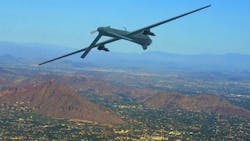A global market for electro-optical (EO) and infrared (IR) components and systems for military applications is expected to grow from an already strong $10.15 billion in 2016 to $14.20 billion in 2022, according to a market study performed by research firm MarketsandMarkets. The rise is estimated at a compound annual growth rate (CAGR) of 5.75% for the six-year period and includes a range of surveillance, detection, and imaging applications made possible by the EO and IR technologies.
The 175-page report, “Military Electro-Optics/Infrared Systems Market by Platform, System (Targeting, Imaging), Technology (Uncooled, Cooled), Sensor Technology (Staring, Scanning), Imaging Technology (Hyperspectral, Multispectral), and Region—Global Forecast to 2022,” points to increased need for situational awareness made possible by these technologies. Healthy investments in research and development by major EO/IR suppliers to aerospace and defense markets have resulted in the miniaturization and improved efficiency of the sensor technology—notably, for “staring” sensors that support surveillance and intelligence, and are vital to military forces. Such sensors are widely used in missile-warning receivers and electronic warfare (EW) systems and tend to be more versatile and cost-effective than scanning sensors.
As EO/IR components become smaller and lighter, they are better suited for application in portable and airborne applications, contributing to an upsurge in the demand for EO/IR sensors. Newer companion technologies, such as unmanned aerial vehicles (UAVs), are being combined with optical sensors for enhanced surveillance and situational awareness capabilities. North America is expected to be the largest portion of the total global military EO/IR market, where optical sensors will also be integrated into public-safety solutions.
About the Author
Jack Browne
Technical Contributor
Jack Browne, Technical Contributor, has worked in technical publishing for over 30 years. He managed the content and production of three technical journals while at the American Institute of Physics, including Medical Physics and the Journal of Vacuum Science & Technology. He has been a Publisher and Editor for Penton Media, started the firm’s Wireless Symposium & Exhibition trade show in 1993, and currently serves as Technical Contributor for that company's Microwaves & RF magazine. Browne, who holds a BS in Mathematics from City College of New York and BA degrees in English and Philosophy from Fordham University, is a member of the IEEE.

